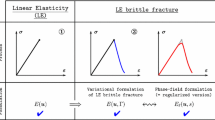Abstract
A linear elastic fracture mechanics analysis of the conditions that produce crack instability is presented. If the initial crack extension causes the change in crack-tip resistance to be negative with respect to the change in crack-tip loading, the crack will continue to propagate even though the loading agent remains stationary, and the crack is defined as unstable. The value of crack-tip load when the crack becomes unstable, G c, is not only a function of the plate material and thickness and fracture mode, but also depends on the specimen geometry and size, and on the compliance of the loading system. The crack-tip resistance, G R, on the other hand, is essentially a property of the plate material and thickness and fracture mode if the crack-propagation is time independent. Once G R has been experimentally determined as a function of crack-propagation distance for a particular plate material and thickness and fracture mode, the value of G e can be calculated for the same material and thickness and fracture mode for any plate configuration for which the elastic stress analysis is known.
Résumé
On rapporte l'analyse des conditions produisant l'instabilité des fissures. Au cas où le prolongement de la fissure initiale modifie la résistance de la pointe de la criqûre à une valeur négative, au regard du changement en charge de la pointe, la fissure continuera à se propager même quand le système de charge reste stationnaire. Dans ce cas, la fissure est considéré comme instable. La valeur de la charge de la pointe d'une fissure instable (G c) n'est pas seulement une caractéristique du matériau du panneau mais dépend en plus de la géometrie de l'échantillon et de ses dimensions ainsi que de la complaisance du système de charge. D'autre part, la résistance de la pointe de la fissure (G R) est essentiellement une caractéristique du matériau du panneau et de son épaisseur ainsi que de son mode de rupture si la propagation de la criqure est indépendant du temps. Autant que l'on aura déterminé G R, par l'expérience, en fonction de la distance de propagation de la fissure pour un matériau de panneau donné et de son épaisseur ainsi que de son mode de rupture, la valcur de G c pent être calculé, pour un même matériau de même épaisseur et mode de rupture, pour toute configuration en panneau dont on sait l'analyse élastique.
Zusammenfassung
In dem Gebiet der Mechanik elastischer linearer Risse ist eine Analyse der Bedingungen, die zur Sprungbestdndigkeit führen, dargestellt. Wenn die ursprüngliche Sprungverlängerung veranlaßt, daß sick die Veranderung in dem Widerstand des Sprungendes in Bezug auf die Veranderung in der Belastung des Sprungendes negativ verhält, wird der Sprung sich weiter verlängern, obwohl das Belastungsmittel stillsteht, and der Sprung wird als widerstandsunfähig bezeichnet. Der Wert der Sprungendenbelastung wenn der Sprung widerstandsunfäbig wird, G c, ist nicht nur eine Funktion des Plattenmaterials, des Plattendicke and dert Art des Risses, sondern hängt auch von der Geometric und der Größe des Stückes, Bowie von der Anpassung des Belastungssystems ab. Wenn, andererseits, die Sprungvergrößerung unabhängig von der Zeit vor sich geht, so ist die Sprungendenfestigkeit, G R, im wesentlichen die Eigenschaft des Plattenmaterials, des Plattendicke and der Art des Risses. Wenn G R erst einmal durch Versuche als Funktion der Länge der Sprungvergrößerung für ein bestimmtes Plattenmaterial, Plattendicke and RiBart bestimmt ist, so kann der Wert von G c für das selbe Material, Dicke and Rißart in jeder Plattengeometrie, für welche die Analyse der elastischen Beanspruchung bekannt ist, bezechnet werden.
Similar content being viewed by others
References
American Society for Testing and Materials, ASTM STP 381 (1965).
American Society for Testing and Materials, ASTM STP 410 (1966).
J. E. Srawley and W. F. Brown, Jr., ASTM STP 381 (1965) 133–196.
H. W. Liu, ASTM STP 381 (1965) 23–26.
W. M. Beebe, AFML-TR-66-249 (November 1966).
G. T. Hahn, A. K. Mukherjee and A. R. Rosenfield, Plastic Zone Formation and Stable Crack Growth in High Strength Alloy Sheets, Presented at National Symposium on Fracture Mechanics, June 1968; to appear in Engineering Fracture Mechanics.
J. M. Krafft, A. M. Sullivan and R. W. Boyle, Proc. Crack Prop. Symp., Cranfield, England, 1, 8 (1961).
J. E. Srawley and B. Gross, NASA TN D-3820 (February 1967).
Author information
Authors and Affiliations
Rights and permissions
About this article
Cite this article
Clausing, D.P. Crack stability in linear elastic fracture mechanics. Int J Fract 5, 211–227 (1969). https://doi.org/10.1007/BF00184613
Received:
Revised:
Issue Date:
DOI: https://doi.org/10.1007/BF00184613




